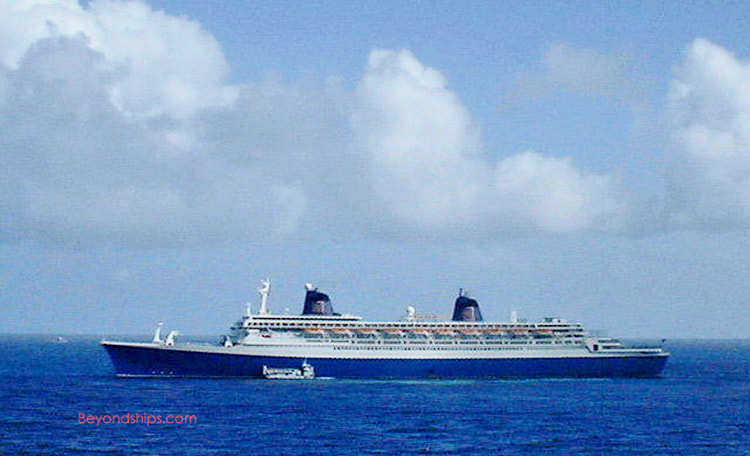SS Norway home page
SUMMARY
The SS Norway is a historic ship because after a career as a traditional ocean liner, she proved that large ships could be successful cruise ships. She was quite popular in both incarnations.
The SS Norway began life as the France. Built in 1962, the France was designed to be a showcase of French design and technology. At 1,035 feet, she was the longest ocean liner ever built - - a record she held until Queen Mary 2 went into service in 2004. When the United States left service in 1969, the France also became the fastest ocean liner in service. Sailing for the French Line, between 1962 and 1974, the France did 377 transatlantic crossings. The ship was known for her contemporary French elegance and became a symbol of national pride in France. However, when transatlantic travel by jet liner caught on, it became financially difficult to offer this service and when the French government ended its operating subsidy, the ship was withdrawn from service and laid-up. At first, the ship was sold to Akram Ojjeh, a Middle Eastern businessman, who had tentative plans to turn the ship into a hotel and/or casino. However, nothing came of these schemes. Then, in 1979, Norwegian Cruise Line's founder, Knut Kloster, purchased the ship for $18 million with the idea of converting her into a cruise ship. This was a bold move because the common wisdom in the cruise industry was that a cruise ship should be small (about 20,000 gross tons) in order to navigate the small, shallow ports of the Caribbean and because there was not enough of a market to fill a larger ship week after week. At over 60,000 gross tons and with a passenger capacity of approximately 2,000, the France was altogether too big. However, what Kloster realized was that a large ship had more space for entertainment facilities and activities to attract more passengers. Furthermore, there would be economies of scale in a larger ship. This visionary thinking has been validated by experience and today the industry is dominated by large ships - - ships much larger than the France. NCL had the France towed to Bremerhaven, Germany where she underwent a $65 million transformation. Two of her four propellers were removed, reducing her top speed from 33 knots to 25 knots. Five thrusters were added to make the ship more maneuverable. Passenger capacity was increased to 2,181 from 2,040 and, to economize, the crew was decreased from 1,100 to 800. Because the ship would now be spending its time cruising warm seas, the air conditioning system was upgraded, the swimming pools were redone and a new one added. Various other changes were made throughout the ship to make her more in keeping with cruising than the formal atmosphere of a traditional transatlantic crossing. Also, two large tenders resembling military landing craft were hung on the bow for use in shuttling passengers to and from shore. (At that time, most small Caribbean ports were not capable of handling a ship the size of the France and so it was envisioned that she would be tendering in most ports). After paying calls in Oslo, Southampton and in New York, the ship, now renamed the Norway, took up residence in Miami. From there, she did weekly cruises to the Bahamas, St. Maarten and St. Thomas USVI. The new Norway, the largest passenger ship in service, became quite popular. Throughout her career as Norway, there were repairs and refits. In 1980, diesel engines were added to power her auxiliary machinery. But, the most ambitious of these refits was in 1990 when 135 cabins were added by placing two decks atop the superstructure around the forward funnel and one deck around the aft funnel. This increased passenger capacity to 2,565 and her gross tonnage to 76,049. At the turn of the century, plans were announced to transfer the ship to NCL's then-affiliate Star Cruises which would operate her as a gambling ship in Asia. A farewell transatlantic crossing quickly sold out. In fact, it was so popular that it was decided to do it again the next year. Norway would stay with NCL throughout her service career. Her career finally came to an end when there was an explosion in the boiler room in May 2003 that killed eight crew members and injured several others. At first, the plan was to repair the Norway and she was towed to Germany for that purpose. However, in the end this proved not to be a viable option. In 2005, Norway was towed to Malaysia where she was sold to scrap dealers. However, plans to break up the ship, now called the Blue Lady, in India were put on hold because of legal proceedings about asbestos and other hazardous materials allegedly in the ship. The ban on the demolition was lifted in 2007 and the ship was broken up at Alang, India. |
Norway in New York during the first of her "last" transatlanic voyages.
|
ESSENTIAL STATISTICSTHE BASICS
CLASS: (individual design) BUILDER: Chantiers de l'Atlantique (France) (re-build: Llyod Werft (Germany)) REGISTRY: France (France) Bahamas (Norway) ENTERED SERVICE: 1962 (France) 1980 (Norway) LINE: French Line (France) Norwegian Cruise Line (Norway) SIZE TONNAGE: 66,348 (France) 76,049 (Norway) LENGTH: 1,035 feet BEAM: 110 feet DRAFT: 34 feet PEOPLE PASSENGERS: 2,040 (France) 2,565 (Norway) CREW: 1,253 (France) 875 (Norway) OFFICERS: French (France) Norway (Norway) TECHNICAL: MAXIMUM SPEED: 34+ knots (France) 25 knots (Norway) SERVICE SPEED: 30 knots (France) 17 knots (Norway) POWER PLANT: Steam turbines (a diesel engine added as Norway) PROPULSION: 4 propellers (France) 2 propellers (Norway) STABILIZERS: Yes |
|
Above: Norway with Queen Elizabeth 2 (QE2).
Below: Norway with a Royal Caribbean Vision class cruise ship.
Below: Norway with a Royal Caribbean Vision class cruise ship.
Profile - (Norwegian Cruise Line, French Line) - SS Norway (SS France)










